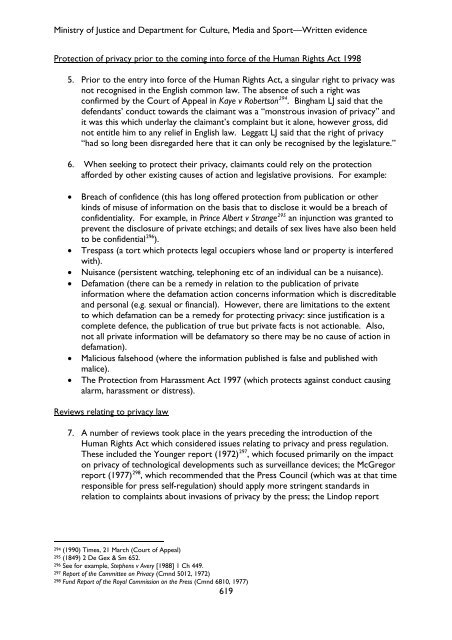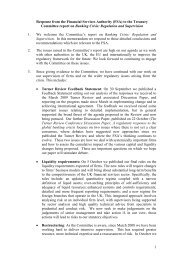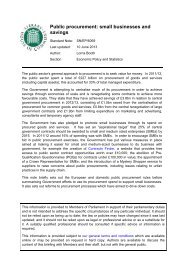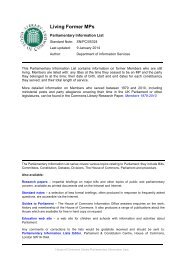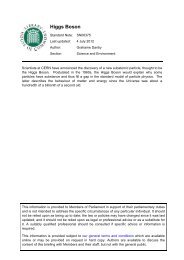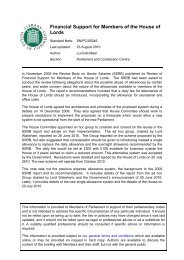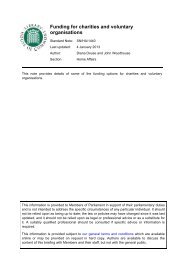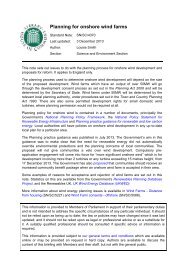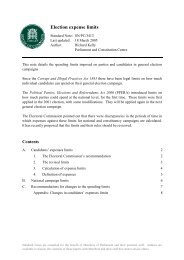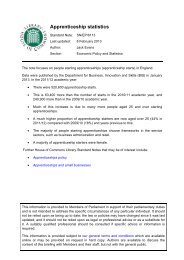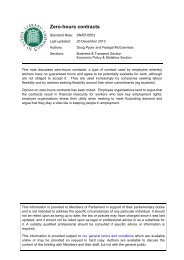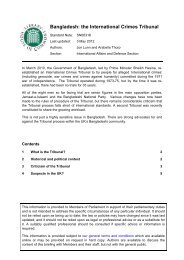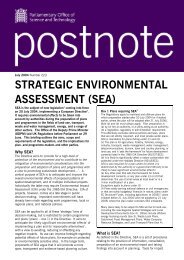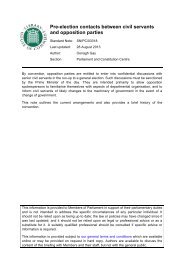- Page 1 and 2:
JOINT COMMITTEE ON PRIVACY AND INJU
- Page 3 and 4:
Andrew Mullins, managing director,
- Page 5 and 6:
National Union of Journalists (NUJ)
- Page 7 and 8:
Ashley Van Haeften, Nicholas Lansma
- Page 9 and 10:
Liz Hartley, Head of Editorial Lega
- Page 11 and 12:
Rt Hon Dominic Grieve QC MP, Attorn
- Page 13 and 14:
Rt Hon Dominic Grieve QC MP, Attorn
- Page 15 and 16:
Rt Hon Dominic Grieve QC MP, Attorn
- Page 17 and 18:
Rt Hon Dominic Grieve QC MP, Attorn
- Page 19 and 20:
Rt Hon Dominic Grieve QC MP, Attorn
- Page 21 and 22:
Rt Hon Dominic Grieve QC MP, Attorn
- Page 23 and 24:
Rt Hon Dominic Grieve QC MP, Attorn
- Page 25 and 26:
BBC—Written evidence BBC—Writte
- Page 27 and 28:
BBC—Written evidence burden to fa
- Page 29 and 30:
BBC—Written evidence Section 2. H
- Page 31 and 32:
BBC—Written evidence outweigh any
- Page 33 and 34:
BBC—Written evidence cases a lack
- Page 35 and 36:
Mr Justice Baker and The Rt Hon. Si
- Page 37 and 38:
Professor Steven Barnett—Written
- Page 39 and 40:
Professor Steven Barnett—Written
- Page 41 and 42:
Professor Steven Barnett—Written
- Page 43 and 44:
Professor Steven Barnett—Written
- Page 45 and 46:
Professor Steven Barnett—Written
- Page 47 and 48:
Monica Bhogal and Rachel Donoghue,
- Page 49 and 50:
Monica Bhogal and Rachel Donoghue,
- Page 51 and 52:
Monica Bhogal and Rachel Donoghue,
- Page 53 and 54:
Monica Bhogal and Rachel Donoghue,
- Page 55 and 56:
Professor Anthony Bradley QC8F —W
- Page 57 and 58:
Professor Anthony Bradley QC8F —W
- Page 59 and 60:
Professor Anthony Bradley QC, David
- Page 61 and 62:
Professor Anthony Bradley QC, David
- Page 63 and 64:
Professor Anthony Bradley QC, David
- Page 65 and 66:
Professor Anthony Bradley QC, David
- Page 67 and 68:
Professor Anthony Bradley QC, David
- Page 69 and 70:
Professor Anthony Bradley QC, David
- Page 71 and 72:
Professor Anthony Bradley QC, David
- Page 73 and 74:
Professor Anthony Bradley QC, David
- Page 75 and 76:
Professor Anthony Bradley QC, David
- Page 77 and 78:
Professor Anthony Bradley QC, David
- Page 79 and 80:
Alastair Brett—Written evidence f
- Page 81 and 82:
Alastair Brett—Written evidence o
- Page 83 and 84:
Alastair Brett—Written evidence
- Page 85 and 86:
British Sky Broadcasting Limited (
- Page 87 and 88:
British Sky Broadcasting Limited (
- Page 89 and 90:
British Sky Broadcasting Limited (
- Page 91 and 92:
Mark Burby—Written evidence Mark
- Page 93 and 94:
Mark Burby—Written evidence (4) i
- Page 95 and 96:
Mark Burby—Written evidence appli
- Page 97 and 98:
Mark Burby—Written evidence raise
- Page 99 and 100:
Mark Burby—Written evidence (b) T
- Page 101 and 102:
Mark Burby—Written evidence they
- Page 103 and 104:
Mark Burby—Written evidence Enfor
- Page 105 and 106:
Mark Burby—Written evidence the p
- Page 107 and 108:
Mark Burby—Supplementary written
- Page 109 and 110:
Mark Burby—Supplementary written
- Page 111 and 112:
Mark Burby—Supplementary written
- Page 113 and 114:
Mark Burby—Supplementary written
- Page 115 and 116:
Mark Burby—Supplementary written
- Page 117 and 118:
Mark Burby—Supplementary written
- Page 119 and 120:
Mark Burby—Supplementary written
- Page 121 and 122:
Archerfield Partners LLP—Written
- Page 123 and 124:
Archerfield Partners LLP—Written
- Page 125 and 126:
Archerfield Partners LLP—Written
- Page 127 and 128:
Archerfield Partners LLP—Written
- Page 129 and 130:
Archerfield Partners LLP—Written
- Page 131 and 132:
Archerfield Partners LLP—Written
- Page 133 and 134:
Carter-Ruck Solicitors—Written ev
- Page 135 and 136:
Carter-Ruck Solicitors—Written ev
- Page 137 and 138:
Carter-Ruck Solicitors—Written ev
- Page 139 and 140:
Carter-Ruck Solicitors—Written ev
- Page 141 and 142:
Carter-Ruck Solicitors—Written ev
- Page 143 and 144:
Carter-Ruck Solicitors—Written ev
- Page 145 and 146:
Carter-Ruck Solicitors—Supplement
- Page 147 and 148:
Professor Brian Cathcart—Written
- Page 149 and 150:
Professor Brian Cathcart—Written
- Page 151 and 152:
Professor Brian Cathcart—Written
- Page 153 and 154:
Professor Brian Cathcart—Written
- Page 155 and 156:
Channel 4—Written evidence Channe
- Page 157 and 158:
Channel 4—Written evidence In Cha
- Page 159 and 160:
Prash Naik, Controller of Legal & C
- Page 161 and 162:
Prash Naik, Controller of Legal & C
- Page 163 and 164:
Prash Naik, Controller of Legal & C
- Page 165 and 166:
Prash Naik, Controller of Legal & C
- Page 167 and 168:
Prash Naik, Controller of Legal & C
- Page 169 and 170:
Prash Naik, Controller of Legal & C
- Page 171 and 172:
Prash Naik, Controller of Legal & C
- Page 173 and 174:
Prash Naik, Controller of Legal & C
- Page 175 and 176:
Prash Naik, Controller of Legal & C
- Page 177 and 178:
Prash Naik, Controller of Legal & C
- Page 179 and 180:
Channel 5—Written evidence 5. Sho
- Page 181 and 182:
Chartered Institute of Journalists
- Page 183 and 184:
Chartered Institute of Journalists
- Page 185 and 186:
Chartered Institute of Journalists
- Page 187 and 188:
Chartered Institute of Journalists
- Page 189 and 190:
James and Margaret Watson—Written
- Page 191 and 192:
Robert Rogers, Clerk of the House o
- Page 193 and 194:
Robert Rogers, Clerk of the House o
- Page 195 and 196:
Robert Rogers, Clerk of the House o
- Page 197 and 198:
Robert Rogers, Clerk of the House o
- Page 199 and 200:
Robert Rogers, Clerk of the House o
- Page 201 and 202:
Robert Rogers, Clerk of the House o
- Page 203 and 204:
Robert Rogers, Clerk of the House o
- Page 205 and 206:
Robert Rogers, Clerk of the House o
- Page 207 and 208:
Robert Rogers, Clerk of the House o
- Page 209 and 210:
Robert Rogers, Clerk of the House o
- Page 211 and 212:
Robert Rogers, Clerk of the House o
- Page 213 and 214:
David Beamish, Clerk of the Parliam
- Page 215 and 216:
David Beamish, Clerk of the Parliam
- Page 217 and 218:
David Beamish, Clerk of the Parliam
- Page 219 and 220:
David Beamish, Clerk of the Parliam
- Page 221 and 222:
David Beamish, Clerk of the Parliam
- Page 223 and 224:
David Beamish, Clerk of the Parliam
- Page 225 and 226:
David Beamish, Clerk of the Parliam
- Page 227 and 228:
David Beamish, Clerk of the Parliam
- Page 229 and 230:
David Beamish, Clerk of the Parliam
- Page 231 and 232:
David Beamish, Clerk of the Parliam
- Page 233 and 234:
Peter Cohen—Written evidence part
- Page 235 and 236:
Peter Cohen—Written evidence appl
- Page 237 and 238:
Peter Cohen—Written evidence Acco
- Page 239 and 240:
Peter Cohen—Written evidence He w
- Page 241 and 242:
Peter Cohen—Written evidence ordi
- Page 243 and 244:
Peter Cohen—Written evidence Appe
- Page 245 and 246:
195HDepartment for Culture, Media a
- Page 247 and 248:
Viscount Rothermere, chairman, Dail
- Page 249 and 250:
Viscount Rothermere, chairman, Dail
- Page 251 and 252:
Viscount Rothermere, chairman, Dail
- Page 253 and 254:
Viscount Rothermere, chairman, Dail
- Page 255 and 256:
Viscount Rothermere, chairman, Dail
- Page 257 and 258:
Viscount Rothermere, chairman, Dail
- Page 259 and 260:
Viscount Rothermere, chairman, Dail
- Page 261 and 262:
Viscount Rothermere, chairman, Dail
- Page 263 and 264:
Viscount Rothermere, chairman, Dail
- Page 265 and 266:
Viscount Rothermere, chairman, Dail
- Page 267 and 268:
Viscount Rothermere, chairman, Dail
- Page 269 and 270:
Charles Garside, Assistant Editor,
- Page 271 and 272:
Paul Farrelly MP—Written evidence
- Page 273 and 274:
Charles Garside, Assistant Editor,
- Page 275 and 276:
Richard Wallace, editor, Daily Mirr
- Page 277 and 278:
Dr David Erdos—Written evidence D
- Page 279 and 280:
Dr David Erdos—Written evidence p
- Page 281 and 282:
Dr David Erdos—Written evidence s
- Page 283 and 284:
Dr David Erdos—Written evidence o
- Page 285 and 286:
Dr David Erdos—Written evidence w
- Page 287 and 288:
Terence Ewing—Written evidence Te
- Page 289 and 290:
Terence Ewing—Written evidence Pr
- Page 291 and 292:
Terence Ewing—Written evidence ov
- Page 293 and 294:
Terence Ewing—Written evidence 66
- Page 295 and 296:
Terence Ewing—Written evidence 88
- Page 297 and 298:
Terence Ewing—Written evidence 11
- Page 299 and 300:
Terence Ewing—Written evidence 12
- Page 301 and 302:
Facebook, Google, and Twitter—Ora
- Page 303 and 304:
Facebook, Google, and Twitter—Ora
- Page 305 and 306:
Facebook, Google, and Twitter—Ora
- Page 307 and 308:
Facebook, Google, and Twitter—Ora
- Page 309 and 310:
Facebook, Google, and Twitter—Ora
- Page 311 and 312:
Facebook, Google, and Twitter—Ora
- Page 313 and 314:
Facebook, Google, and Twitter—Ora
- Page 315 and 316:
Facebook, Google, and Twitter—Ora
- Page 317 and 318:
Facebook, Google, and Twitter—Ora
- Page 319 and 320:
Facebook, Google, and Twitter—Ora
- Page 321 and 322:
Facebook, Google, and Twitter—Ora
- Page 323 and 324:
Facebook, Google, and Twitter—Ora
- Page 325 and 326:
Foot Anstey LLP—Written evidence
- Page 327 and 328:
Professor Chris Frost—Written evi
- Page 329 and 330:
Professor Chris Frost—Written evi
- Page 331 and 332:
Global Witness—Written evidence G
- Page 333 and 334:
Global Witness—Written evidence 8
- Page 335 and 336:
Zac Goldsmith MP, Max Mosley, Steve
- Page 337 and 338:
Lord Grabiner QC and Dr Kirsty Hugh
- Page 339 and 340:
Lord Grabiner QC and Dr Kirsty Hugh
- Page 341 and 342:
Lord Grabiner QC and Dr Kirsty Hugh
- Page 343 and 344:
Lord Grabiner QC and Dr Kirsty Hugh
- Page 345 and 346:
Lord Grabiner QC and Dr Kirsty Hugh
- Page 347 and 348:
Lord Grabiner QC and Dr Kirsty Hugh
- Page 349 and 350:
Lord Grabiner QC and Dr Kirsty Hugh
- Page 351 and 352:
Lord Grabiner QC and Dr Kirsty Hugh
- Page 353 and 354:
Lord Grabiner QC and Dr Kirsty Hugh
- Page 355 and 356:
Lord Grabiner QC and Dr Kirsty Hugh
- Page 357 and 358:
Lord Grabiner QC and Dr Kirsty Hugh
- Page 359 and 360:
Lord Grabiner QC and Dr Kirsty Hugh
- Page 361 and 362:
Lord Grabiner QC and Dr Kirsty Hugh
- Page 363 and 364:
Lord Grabiner QC and Dr Kirsty Hugh
- Page 365 and 366:
Lord Grabiner QC and Dr Kirsty Hugh
- Page 367 and 368:
Hugh Grant—Written evidence 9) An
- Page 369 and 370:
Hugh Grant—Written evidence singe
- Page 371 and 372:
Hugh Grant, Max Mosley, Steve Cooga
- Page 373 and 374:
Jonathan Grun, Press Association—
- Page 375 and 376:
Guardian News and Media Limited (GN
- Page 377 and 378:
Guardian News and Media Limited (GN
- Page 379 and 380:
Guardian News and Media Limited (GN
- Page 381 and 382:
Alan Rusbridger, Editor, The Guardi
- Page 383 and 384:
Alan Rusbridger, Editor, The Guardi
- Page 385 and 386:
Alan Rusbridger, Editor, The Guardi
- Page 387 and 388:
Alan Rusbridger, Editor, The Guardi
- Page 389 and 390:
Alan Rusbridger, Editor, The Guardi
- Page 391 and 392:
Alan Rusbridger, Editor, The Guardi
- Page 393 and 394:
Alan Rusbridger, Editor, The Guardi
- Page 395 and 396:
Alan Rusbridger, Editor, The Guardi
- Page 397 and 398:
Alan Rusbridger, Editor, The Guardi
- Page 399 and 400:
Alan Rusbridger, Editor, The Guardi
- Page 401 and 402:
Alex Hall—Written Evidence Alex H
- Page 403 and 404:
Alex Hall and Charlotte Harris, par
- Page 405 and 406:
Alex Hall and Charlotte Harris, par
- Page 407 and 408:
Alex Hall and Charlotte Harris, par
- Page 409 and 410:
Alex Hall and Charlotte Harris, par
- Page 411 and 412:
Alex Hall and Charlotte Harris, par
- Page 413 and 414:
Alex Hall and Charlotte Harris, par
- Page 415 and 416:
Alex Hall and Charlotte Harris, par
- Page 417 and 418:
Alex Hall and Charlotte Harris, par
- Page 419 and 420:
Alex Hall and Charlotte Harris, par
- Page 421 and 422:
Alex Hall and Charlotte Harris, par
- Page 423 and 424:
Alex Hall and Charlotte Harris, par
- Page 425 and 426:
Alex Hall and Charlotte Harris, par
- Page 427 and 428:
Phil Hall, chairman, PHA Media and
- Page 429 and 430:
Phil Hall, chairman, PHA Media and
- Page 431 and 432:
Phil Hall, chairman, PHA Media and
- Page 433 and 434:
Phil Hall, chairman, PHA Media and
- Page 435 and 436:
Phil Hall, chairman, PHA Media and
- Page 437 and 438:
Phil Hall, chairman, PHA Media and
- Page 439 and 440:
Phil Hall, chairman, PHA Media and
- Page 441 and 442:
Phil Hall, chairman, PHA Media and
- Page 443 and 444:
Phil Hall, chairman, PHA Media and
- Page 445 and 446:
Phil Hall, chairman, PHA Media and
- Page 447 and 448:
David Howarth138F —Written eviden
- Page 449 and 450:
David Howarth138F —Written eviden
- Page 451 and 452:
David Howarth, Professor Anthony Br
- Page 453 and 454:
Chris Blackhurst, editor, The Indep
- Page 455 and 456:
Chris Blackhurst, editor, The Indep
- Page 457 and 458:
Chris Blackhurst, editor, The Indep
- Page 459 and 460:
Chris Blackhurst, editor, The Indep
- Page 461 and 462:
Chris Blackhurst, editor, The Indep
- Page 463 and 464:
Chris Blackhurst, editor, The Indep
- Page 465 and 466:
Chris Blackhurst, editor, The Indep
- Page 467 and 468:
Chris Blackhurst, editor, The Indep
- Page 469 and 470:
Chris Blackhurst, editor, The Indep
- Page 471 and 472:
ITN—Written evidence ITN—Writte
- Page 473 and 474:
ITN—Written evidence The experien
- Page 475 and 476:
ITN—Written evidence 9. Should Of
- Page 477 and 478:
ITV—Written evidence ITV—Writte
- Page 479 and 480:
ITV—Written evidence There are ex
- Page 481 and 482:
ITV—Written evidence Given the ex
- Page 483 and 484:
Andreas Kolbe and Dr Edward Buckner
- Page 485 and 486:
Andreas Kolbe and Dr Edward Buckner
- Page 487 and 488:
Andreas Kolbe and Dr Edward Buckner
- Page 489 and 490:
Andreas Kolbe and Dr Edward Buckner
- Page 491 and 492:
Andreas Kolbe and Dr Edward Buckner
- Page 493 and 494:
Andreas Kolbe and Dr Edward Buckner
- Page 495 and 496:
Law Society—Written evidence Law
- Page 497 and 498:
Law Society—Written evidence Ques
- Page 499 and 500:
Law Society—Written evidence •
- Page 501 and 502:
Law Society—Written evidence inte
- Page 503 and 504:
Law Society—Written evidence •
- Page 505 and 506:
Law Society—Written evidence •
- Page 507 and 508:
Lawyers for Media Standards—Writt
- Page 509 and 510:
Lawyers for Media Standards—Writt
- Page 511 and 512:
Lawyers for Media Standards—Writt
- Page 513 and 514:
Lawyers for Media Standards—Writt
- Page 515 and 516:
Lord Lester of Herne Hill QC—Writ
- Page 517 and 518:
Lord Lester of Herne Hill QC—Writ
- Page 519 and 520:
Lord Lester of Herne Hill QC—Writ
- Page 521 and 522:
Lord Lester of Herne Hill QC—Writ
- Page 523 and 524:
Lord Lester of Herne Hill QC—Writ
- Page 525 and 526:
Lord Lester of Herne Hill QC—Writ
- Page 527 and 528:
Lord Lester of Herne Hill QC—Writ
- Page 529 and 530:
Lord Lester of Herne Hill QC—Writ
- Page 531 and 532:
Lord Lester of Herne Hill QC—Writ
- Page 533 and 534:
Lord Lester of Herne Hill QC—Writ
- Page 535 and 536:
Lord Lester of Herne Hill QC—Writ
- Page 537 and 538:
Lord Lester of Herne Hill QC—Writ
- Page 539 and 540:
Lord Lester of Herne Hill QC—Writ
- Page 541 and 542:
Lewis Silkin LLP—Written evidence
- Page 543 and 544:
Lewis Silkin LLP—Written evidence
- Page 545 and 546:
Lewis Silkin LLP—Written evidence
- Page 547 and 548:
Lewis Silkin LLP—Written evidence
- Page 549 and 550:
Lewis Silkin LLP—Written evidence
- Page 551 and 552:
Peter Wright, editor, Mail on Sunda
- Page 553 and 554:
Martin Clarke, publisher, Mail Onli
- Page 555 and 556:
Martin Clarke, publisher, Mail Onli
- Page 557 and 558:
Martin Clarke, publisher, Mail Onli
- Page 559 and 560:
Martin Clarke, publisher, Mail Onli
- Page 561 and 562:
Martin Clarke, publisher, Mail Onli
- Page 563 and 564:
Martin Clarke, publisher, Mail Onli
- Page 565 and 566:
Martin Clarke, publisher, Mail Onli
- Page 567 and 568: Martin Clarke, publisher, Mail Onli
- Page 569 and 570: Martin Clarke, publisher, Mail Onli
- Page 571 and 572: Martin Clarke, publisher, Mail Onli
- Page 573 and 574: Martin Clarke, publisher, Mail Onli
- Page 575 and 576: Martin Clarke, publisher, Mail Onli
- Page 577 and 578: Martin Clarke, publisher, Mail Onli
- Page 579 and 580: Mr Andrew Marr—Written evidence r
- Page 581 and 582: Sir William McKay—Written evidenc
- Page 583 and 584: Sir William McKay—Written evidenc
- Page 585 and 586: Sir William McKay KCB, David Howart
- Page 587 and 588: Media Standards Trust—Written evi
- Page 589 and 590: Media Standards Trust—Written evi
- Page 591 and 592: Media Standards Trust—Written evi
- Page 593 and 594: Media Standards Trust—Written evi
- Page 595 and 596: Media Standards Trust—Written evi
- Page 597 and 598: Sir Christopher Meyer, Martin Moore
- Page 599 and 600: Sir Christopher Meyer, Martin Moore
- Page 601 and 602: Sir Christopher Meyer, Martin Moore
- Page 603 and 604: Sir Christopher Meyer, Martin Moore
- Page 605 and 606: Sir Christopher Meyer, Martin Moore
- Page 607 and 608: Sir Christopher Meyer, Martin Moore
- Page 609 and 610: Sir Christopher Meyer, Martin Moore
- Page 611 and 612: Sir Christopher Meyer, Martin Moore
- Page 613 and 614: Sir Christopher Meyer, Martin Moore
- Page 615 and 616: Sir Christopher Meyer, Martin Moore
- Page 617: Peter Milledge, Deputy Counsel to t
- Page 621 and 622: Ministry of Justice and Department
- Page 623 and 624: Ministry of Justice and Department
- Page 625 and 626: Ministry of Justice and Department
- Page 627 and 628: Ministry of Justice and Department
- Page 629 and 630: Ministry of Justice and Department
- Page 631 and 632: Ministry of Justice and Department
- Page 633 and 634: Ministry of Justice and Department
- Page 635 and 636: Ministry of Justice and Department
- Page 637 and 638: Ministry of Justice and Department
- Page 639 and 640: Ministry of Justice and Department
- Page 641 and 642: Ministry of Justice and Department
- Page 643 and 644: Ministry of Justice and Department
- Page 645 and 646: Ministry of Justice and Department
- Page 647 and 648: Ministry of Justice and Department
- Page 649 and 650: Ministry of Justice and Department
- Page 651 and 652: Ministry of Justice and Department
- Page 653 and 654: Ministry of Justice and Department
- Page 655 and 656: Ministry of Justice and Department
- Page 657 and 658: Ministry of Justice and Department
- Page 659 and 660: Ministry of Justice and Department
- Page 661 and 662: Ministry of Justice and Department
- Page 663 and 664: Ministry of Justice and Department
- Page 665 and 666: Rt Hon Kenneth Clarke QC MP, Lord C
- Page 667 and 668: Rt Hon Kenneth Clarke QC MP, Lord C
- Page 669 and 670:
Rt Hon Kenneth Clarke QC MP, Lord C
- Page 671 and 672:
Rt Hon Kenneth Clarke QC MP, Lord C
- Page 673 and 674:
Rt Hon Kenneth Clarke QC MP, Lord C
- Page 675 and 676:
Rt Hon Kenneth Clarke QC MP, Lord C
- Page 677 and 678:
Rt Hon Kenneth Clarke QC MP, Lord C
- Page 679 and 680:
Rt Hon Kenneth Clarke QC MP, Lord C
- Page 681 and 682:
Rt Hon Kenneth Clarke QC MP, Lord C
- Page 683 and 684:
Rt Hon Kenneth Clarke QC MP, Lord C
- Page 685 and 686:
Rt Hon Kenneth Clarke QC MP, Lord C
- Page 687 and 688:
Rt Hon Kenneth Clarke QC MP, Lord C
- Page 689 and 690:
Max Mosley—Written evidence Max M
- Page 691 and 692:
Max Mosley—Written evidence No. A
- Page 693 and 694:
Max Mosley—Written evidence 3. Is
- Page 695 and 696:
Max Mosley—Written evidence It ha
- Page 697 and 698:
Max Mosley—Written evidence The r
- Page 699 and 700:
Max Mosley, Steve Coogan, Zac Golds
- Page 701 and 702:
Max Mosley, Steve Coogan, Zac Golds
- Page 703 and 704:
Max Mosley, Steve Coogan, Zac Golds
- Page 705 and 706:
Max Mosley, Steve Coogan, Zac Golds
- Page 707 and 708:
Max Mosley, Steve Coogan, Zac Golds
- Page 709 and 710:
Max Mosley, Steve Coogan, Zac Golds
- Page 711 and 712:
Max Mosley, Steve Coogan, Zac Golds
- Page 713 and 714:
Max Mosley, Steve Coogan, Zac Golds
- Page 715 and 716:
Max Mosley, Steve Coogan, Zac Golds
- Page 717 and 718:
Max Mosley, Steve Coogan, Zac Golds
- Page 719 and 720:
Max Mosley, Steve Coogan, Zac Golds
- Page 721 and 722:
Max Mosley, Steve Coogan, Zac Golds
- Page 723 and 724:
get us started. What positives and
- Page 725 and 726:
at here is that you, as the UK Parl
- Page 727 and 728:
Q547 Mr Bradshaw: Is that a free sp
- Page 729 and 730:
Ashley Van Haeften: Can I pick up o
- Page 731 and 732:
Nicholas Lansman: Well, there is a
- Page 733 and 734:
substantive law. The issue is that
- Page 735 and 736:
then under an obligation to take it
- Page 737 and 738:
Q572 Ms Stuart: Just before you get
- Page 739 and 740:
legislation can happily apply to th
- Page 741 and 742:
National Union of Journalists (NUJ)
- Page 743 and 744:
National Union of Journalists (NUJ)
- Page 745 and 746:
National Union of Journalists (NUJ)
- Page 747 and 748:
National Union of Journalists (NUJ)
- Page 749 and 750:
The Rt Hon. the Lord Neuberger of A
- Page 751 and 752:
The Rt Hon. the Lord Neuberger of A
- Page 753 and 754:
The Rt Hon. the Lord Neuberger of A
- Page 755 and 756:
The Rt Hon. the Lord Neuberger of A
- Page 757 and 758:
The Rt Hon. the Lord Neuberger of A
- Page 759 and 760:
The Rt Hon. the Lord Neuberger of A
- Page 761 and 762:
The Rt Hon. the Lord Neuberger of A
- Page 763 and 764:
The Rt Hon. the Lord Neuberger of A
- Page 765 and 766:
The Rt Hon. the Lord Neuberger of A
- Page 767 and 768:
The Rt Hon. the Lord Neuberger of A
- Page 769 and 770:
The Rt Hon. the Lord Neuberger of A
- Page 771 and 772:
Richard Caseby, Group Managing Edit
- Page 773 and 774:
Richard Caseby, Group Managing Edit
- Page 775 and 776:
Richard Caseby, Group Managing Edit
- Page 777 and 778:
Richard Caseby, Group Managing Edit
- Page 779 and 780:
Richard Caseby, Group Managing Edit
- Page 781 and 782:
Richard Caseby, Group Managing Edit
- Page 783 and 784:
Richard Caseby, Group Managing Edit
- Page 785 and 786:
Richard Caseby, Group Managing Edit
- Page 787 and 788:
Richard Caseby, Group Managing Edit
- Page 789 and 790:
Richard Caseby, Group Managing Edit
- Page 791 and 792:
Richard Caseby, Group Managing Edit
- Page 793 and 794:
Richard Caseby, Group Managing Edit
- Page 795 and 796:
Richard Caseby, Group Managing Edit
- Page 797 and 798:
The Newspaper Society—Written evi
- Page 799 and 800:
The Newspaper Society—Written evi
- Page 801 and 802:
The Newspaper Society—Written evi
- Page 803 and 804:
The Newspaper Society—Written evi
- Page 805 and 806:
The Newspaper Society—Written evi
- Page 807 and 808:
The Newspaper Society—Written evi
- Page 809 and 810:
Richard Desmond, chairman, Northern
- Page 811 and 812:
Richard Desmond, chairman, Northern
- Page 813 and 814:
Richard Desmond, chairman, Northern
- Page 815 and 816:
Richard Desmond, chairman, Northern
- Page 817 and 818:
Richard Desmond, chairman, Northern
- Page 819 and 820:
Richard Desmond, chairman, Northern
- Page 821 and 822:
Richard Desmond, chairman, Northern
- Page 823 and 824:
Richard Desmond, chairman, Northern
- Page 825 and 826:
Richard Desmond, chairman, Northern
- Page 827 and 828:
Richard Desmond, chairman, Northern
- Page 829 and 830:
Richard Desmond, chairman, Northern
- Page 831 and 832:
Paul Ashford, Editorial Director, N
- Page 833 and 834:
Open Digital Policy Organisation—
- Page 835 and 836:
Open Digital Policy Organisation—
- Page 837 and 838:
Professor Julian Petley—Written e
- Page 839 and 840:
Professor Julian Petley—Written e
- Page 841 and 842:
Professor Julian Petley—Written e
- Page 843 and 844:
Professor Julian Petley—Written e
- Page 845 and 846:
Professor Julian Petley—Written e
- Page 847 and 848:
Professor Gavin Phillipson, The Rt
- Page 849 and 850:
Professor Gavin Phillipson—Writte
- Page 851 and 852:
Professor Gavin Phillipson—Writte
- Page 853 and 854:
Professor Gavin Phillipson—Writte
- Page 855 and 856:
Professor Gavin Phillipson—Writte
- Page 857 and 858:
Professor Gavin Phillipson—Writte
- Page 859 and 860:
Press Complaints Commission—Writt
- Page 861 and 862:
Press Complaints Commission—Writt
- Page 863 and 864:
Press Complaints Commission—Writt
- Page 865 and 866:
Press Complaints Commission—Writt
- Page 867 and 868:
Press Complaints Commission—Writt
- Page 869 and 870:
Press Complaints Commission—Writt
- Page 871 and 872:
Press Complaints Commission—Writt
- Page 873 and 874:
Press Complaints Commission—Writt
- Page 875 and 876:
Press Complaints Commission—Writt
- Page 877 and 878:
Press Complaints Commission—Writt
- Page 879 and 880:
Press Complaints Commission—Writt
- Page 881 and 882:
Press Complaints Commission—Writt
- Page 883 and 884:
Press Complaints Commission—Writt
- Page 885 and 886:
Press Complaints Commission—Writt
- Page 887 and 888:
Press Complaints Commission—Writt
- Page 889 and 890:
Press Complaints Commission—Writt
- Page 891 and 892:
Press Complaints Commission—Writt
- Page 893 and 894:
Press Complaints Commission—Writt
- Page 895 and 896:
Press Complaints Commission—Writt
- Page 897 and 898:
Press Complaints Commission—Writt
- Page 899 and 900:
Press Complaints Commission—Writt
- Page 901 and 902:
Press Complaints Commission—Writt
- Page 903 and 904:
Press Complaints Commission—Writt
- Page 905 and 906:
Press Complaints Commission—Writt
- Page 907 and 908:
Press Complaints Commission—Writt
- Page 909 and 910:
Press Complaints Commission—Writt
- Page 911 and 912:
Press Complaints Commission—Writt
- Page 913 and 914:
Press Complaints Commission—Writt
- Page 915 and 916:
Press Complaints Commission—Writt
- Page 917 and 918:
Press Complaints Commission—Writt
- Page 919 and 920:
Press Complaints Commission—Writt
- Page 921 and 922:
Press Complaints Commission—Writt
- Page 923 and 924:
Press Complaints Commission—Writt
- Page 925 and 926:
Press Complaints Commission—Writt
- Page 927 and 928:
Press Complaints Commission—Writt
- Page 929 and 930:
Press Complaints Commission—Writt
- Page 931 and 932:
Press Complaints Commission—Writt
- Page 933 and 934:
Press Complaints Commission—Writt
- Page 935 and 936:
Press Complaints Commission—Writt
- Page 937 and 938:
Press Complaints Commission—Writt
- Page 939 and 940:
Press Complaints Commission—Writt
- Page 941 and 942:
Press Complaints Commission—Writt
- Page 943 and 944:
Press Complaints Commission—Writt
- Page 945 and 946:
Press Complaints Commission—Writt
- Page 947 and 948:
Press Complaints Commission, Ofcom,
- Page 949 and 950:
Press Complaints Commission, Ofcom,
- Page 951 and 952:
Press Complaints Commission, Ofcom,
- Page 953 and 954:
Press Complaints Commission, Ofcom,
- Page 955 and 956:
Press Complaints Commission, Ofcom,
- Page 957 and 958:
Press Complaints Commission, Ofcom,
- Page 959 and 960:
Press Complaints Commission, Ofcom,
- Page 961 and 962:
Press Complaints Commission, Ofcom,
- Page 963 and 964:
Press Complaints Commission, Ofcom,
- Page 965 and 966:
Press Complaints Commission, Ofcom,
- Page 967 and 968:
Lord Hunt of Wirral, Chair, Press C
- Page 969 and 970:
Lord Hunt of Wirral, Chair, Press C
- Page 971 and 972:
Lord Hunt of Wirral, Chair, Press C
- Page 973 and 974:
Lord Hunt of Wirral, Chair, Press C
- Page 975 and 976:
Lord Hunt of Wirral, Chair, Press C
- Page 977 and 978:
Lord Hunt of Wirral, Chair, Press C
- Page 979 and 980:
Lord Hunt of Wirral, Chair, Press C
- Page 981 and 982:
Lord Hunt of Wirral, Chair, Press C
- Page 983 and 984:
David Price QC, Gavin Millar QC, Gi
- Page 985 and 986:
David Price QC, Gavin Millar QC, Gi
- Page 987 and 988:
David Price QC, Gavin Millar QC, Gi
- Page 989 and 990:
David Price QC, Gavin Millar QC, Gi
- Page 991 and 992:
David Price QC, Gavin Millar QC, Gi
- Page 993 and 994:
David Price QC, Gavin Millar QC, Gi
- Page 995 and 996:
David Price QC, Gavin Millar QC, Gi
- Page 997 and 998:
David Price QC, Gavin Millar QC, Gi
- Page 999 and 1000:
David Price QC, Gavin Millar QC, Gi
- Page 1001 and 1002:
David Price QC, Gavin Millar QC, Gi
- Page 1003 and 1004:
Ian Hislop, Editor, Private Eye, Al
- Page 1005 and 1006:
Ian Hislop, Editor, Private Eye—S
- Page 1007 and 1008:
Ian Hislop, Editor, Private Eye—S
- Page 1009 and 1010:
Professional Negligence Lawyers’
- Page 1011 and 1012:
Professional Negligence Lawyers’
- Page 1013 and 1014:
Professional Negligence Lawyers’
- Page 1015 and 1016:
The Professional Negligence Lawyers
- Page 1017 and 1018:
Joshua Rozenberg, Professor Steven
- Page 1019 and 1020:
Joshua Rozenberg, Professor Steven
- Page 1021 and 1022:
Joshua Rozenberg, Professor Steven
- Page 1023 and 1024:
Joshua Rozenberg, Professor Steven
- Page 1025 and 1026:
Joshua Rozenberg, Professor Steven
- Page 1027 and 1028:
Joshua Rozenberg, Professor Steven
- Page 1029 and 1030:
Joshua Rozenberg, Professor Steven
- Page 1031 and 1032:
Joshua Rozenberg, Professor Steven
- Page 1033 and 1034:
Joshua Rozenberg, Professor Steven
- Page 1035 and 1036:
Joshua Rozenberg, Professor Steven
- Page 1037 and 1038:
Schillings—Written evidence Schil
- Page 1039 and 1040:
Schillings—Written evidence the B
- Page 1041 and 1042:
Schillings—Written evidence provi
- Page 1043 and 1044:
Schillings—Written evidence carri
- Page 1045 and 1046:
Schillings—Written evidence Damag
- Page 1047 and 1048:
Schillings—Written evidence We be
- Page 1049 and 1050:
Schillings—Written evidence • S
- Page 1051 and 1052:
Schillings, Carter Ruck Solicitors,
- Page 1053 and 1054:
Dr Andrew Scott—Written evidence
- Page 1055 and 1056:
Dr Andrew Scott—Written evidence
- Page 1057 and 1058:
Dr Andrew Scott—Written evidence
- Page 1059 and 1060:
Dr Andrew Scott—Written evidence
- Page 1061 and 1062:
Dr Andrew Scott—Written evidence
- Page 1063 and 1064:
Dr Andrew Scott—Written evidence
- Page 1065 and 1066:
The Rt Hon. Sir Stephen Sedley, The
- Page 1067 and 1068:
Society of Editors—Written eviden
- Page 1069 and 1070:
Society of Editors—Written eviden
- Page 1071 and 1072:
Bob Satchwell, Executive Director,
- Page 1073 and 1074:
Paul Staines, Jamie East, David All
- Page 1075 and 1076:
Paul Staines, Jamie East, David All
- Page 1077 and 1078:
Paul Staines, Jamie East, David All
- Page 1079 and 1080:
Paul Staines, Jamie East, David All
- Page 1081 and 1082:
Paul Staines, Jamie East, David All
- Page 1083 and 1084:
Paul Staines, Jamie East, David All
- Page 1085 and 1086:
Paul Staines, Jamie East, David All
- Page 1087 and 1088:
Paul Staines, Jamie East, David All
- Page 1089 and 1090:
Paul Staines, Jamie East, David All
- Page 1091 and 1092:
Paul Staines, Jamie East, David All
- Page 1093 and 1094:
Paul Staines, Jamie East, David All
- Page 1095 and 1096:
The Rt Hon. Jack Straw MP, The Rt H
- Page 1097 and 1098:
The Rt Hon. Jack Straw MP, The Rt H
- Page 1099 and 1100:
The Rt Hon. Jack Straw MP, The Rt H
- Page 1101 and 1102:
The Rt Hon. Jack Straw MP, The Rt H
- Page 1103 and 1104:
The Rt Hon. Jack Straw MP, The Rt H
- Page 1105 and 1106:
The Rt Hon. Jack Straw MP, The Rt H
- Page 1107 and 1108:
The Rt Hon. Jack Straw MP, The Rt H
- Page 1109 and 1110:
The Rt Hon. Jack Straw MP, The Rt H
- Page 1111 and 1112:
The Rt Hon. Jack Straw MP, The Rt H
- Page 1113 and 1114:
The Rt Hon. Jack Straw MP, The Rt H
- Page 1115 and 1116:
The Rt Hon. Jack Straw MP, The Rt H
- Page 1117 and 1118:
The Rt Hon. Jack Straw MP, The Rt H
- Page 1119 and 1120:
Richard Walker, Editor, Sunday Hera
- Page 1121 and 1122:
Richard Walker, Editor, Sunday Hera
- Page 1123 and 1124:
Richard Walker, Editor, Sunday Hera
- Page 1125 and 1126:
Richard Walker, Editor, Sunday Hera
- Page 1127 and 1128:
Richard Walker, Editor, Sunday Hera
- Page 1129 and 1130:
Richard Walker, Editor, Sunday Hera
- Page 1131 and 1132:
Richard Walker, Editor, Sunday Hera
- Page 1133 and 1134:
Richard Walker, Editor, Sunday Hera
- Page 1135 and 1136:
Richard Walker, Editor, Sunday Hera
- Page 1137 and 1138:
Richard Walker, Editor, Sunday Hera
- Page 1139 and 1140:
Richard Walker, Editor, Sunday Hera
- Page 1141 and 1142:
Matt McKenzie, Editor The Sunday Su
- Page 1143 and 1144:
Edward Roussel, Digital Editor, Tel
- Page 1145 and 1146:
Philip Webster, Editor, Times Onlin
- Page 1147 and 1148:
James Harding, editor, The Times, P
- Page 1149 and 1150:
James Harding, editor, The Times, P
- Page 1151 and 1152:
James Harding, editor, The Times, P
- Page 1153 and 1154:
James Harding, editor, The Times, P
- Page 1155 and 1156:
James Harding, editor, The Times, P
- Page 1157 and 1158:
James Harding, editor, The Times, P
- Page 1159 and 1160:
James Harding, editor, The Times, P
- Page 1161 and 1162:
John Witherow, Editor, The Sunday T
- Page 1163 and 1164:
Hugh Tomlinson QC—Written evidenc
- Page 1165 and 1166:
Hugh Tomlinson QC—Written evidenc
- Page 1167 and 1168:
Hugh Tomlinson QC—Written evidenc
- Page 1169 and 1170:
Hugh Tomlinson QC—Written evidenc
- Page 1171 and 1172:
Hugh Tomlinson QC, Schillings, and
- Page 1173 and 1174:
Hugh Tomlinson QC, Schillings, and
- Page 1175 and 1176:
Hugh Tomlinson QC, Schillings, and
- Page 1177 and 1178:
Hugh Tomlinson QC, Schillings, and
- Page 1179 and 1180:
Hugh Tomlinson QC, Schillings, and
- Page 1181 and 1182:
Hugh Tomlinson QC, Schillings, and
- Page 1183 and 1184:
Hugh Tomlinson QC, Schillings, and
- Page 1185 and 1186:
Hugh Tomlinson QC, Schillings, and
- Page 1187 and 1188:
Hugh Tomlinson QC, Schillings, and
- Page 1189 and 1190:
Trinity Mirror plc, and Richard Wal
- Page 1191 and 1192:
Trinity Mirror plc, and Richard Wal
- Page 1193 and 1194:
Trinity Mirror plc, and Richard Wal
- Page 1195 and 1196:
Trinity Mirror plc, and Richard Wal
- Page 1197 and 1198:
Trinity Mirror plc, and Richard Wal
- Page 1199 and 1200:
Trinity Mirror plc, and Richard Wal
- Page 1201 and 1202:
Trinity Mirror plc, and Richard Wal
- Page 1203 and 1204:
Trinity Mirror plc, and Richard Wal
- Page 1205 and 1206:
Trinity Mirror plc, and Richard Wal
- Page 1207 and 1208:
Trinity Mirror plc, and Richard Wal
- Page 1209 and 1210:
Marcus Partington, Trinity Mirror P
- Page 1211 and 1212:
Twitter, Facebook, and Google—Ora
- Page 1213 and 1214:
The Rt Hon. Lord Wakeham, The Rt Ho
- Page 1215 and 1216:
The Rt Hon. the Lord Wakeham DL—W
- Page 1217 and 1218:
The Rt Hon. Sir Nicholas Wall and M
- Page 1219 and 1220:
The Rt Hon. Sir Nicholas Wall and M
- Page 1221 and 1222:
The Rt Hon. Sir Nicholas Wall and M
- Page 1223 and 1224:
The Rt Hon. Sir Nicholas Wall and M
- Page 1225 and 1226:
The Rt Hon. Sir Nicholas Wall and M
- Page 1227 and 1228:
The Rt Hon. Sir Nicholas Wall and M
- Page 1229 and 1230:
The Rt Hon. Sir Nicholas Wall and M
- Page 1231 and 1232:
Richard Wilson—Supplementary writ
- Page 1233 and 1234:
Richard Wilson—Supplementary writ
- Page 1235 and 1236:
Richard Wilson—Supplementary writ
- Page 1237 and 1238:
Withers LLP—Written evidence This
- Page 1239 and 1240:
Withers LLP—Written evidence prop
- Page 1241:
Withers LLP—Written evidence The


